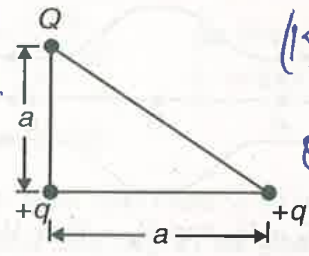Three charges +Q, q, +Q are placed respectively, at distance, 0, d//2 and d from the origin, on the x-axis. If the net force experienced by +Q placed at x=0, is zero, then value of q is :
−Q/4
+Q/2
Q/4
−Q/2
To solve the problem, we need to analyze the forces acting on the charge +Q located at x=0. The charges are positioned as follows:
- Charge +Q at x=0
- Charge q at x=d2
- Charge +Q at x=d
Step 1: Identify the Forces Acting on Charge +Q
1. Force due to Charge +Q at x=d:
The force F1 on charge +Q at x=0 due to the charge +Q at x=d is given by Coulomb's law:
F1=kQ⋅Qd2=kQ2d2
This force acts in the positive x-direction (to the right).
2. Force due to Charge q at x=d2:
The force F2 on charge +Q at x=0 due to the charge q at x=d2 is:
F2=kQ⋅q(d2)2=kQ⋅qd24=4kQqd2
This force acts in the negative x-direction (to the left) since q is a charge that can be either positive or negative.
Step 2: Set the Net Force to Zero
For the net force on charge +Q at x=0 to be zero, the forces must balance:
F1−F2=0
Substituting the expressions for F1 and F2:
kQ2d2−4kQqd2=0
Step 3: Simplify the Equation
We can factor out kd2 (which is non-zero) from the equation:
Q2−4Qq=0
Step 4: Solve for q
Factoring gives:
Q(Q−4q)=0
Since Q≠0, we have:
Q−4q=0⟹4q=Q⟹q=Q4
Conclusion
The value of charge q is:
q=Q4
- Charge q at x=d2
- Charge +Q at x=d
The force F1 on charge +Q at x=0 due to the charge +Q at x=d is given by Coulomb's law:
F1=kQ⋅Qd2=kQ2d2
This force acts in the positive x-direction (to the right).
The force F2 on charge +Q at x=0 due to the charge q at x=d2 is:
F2=kQ⋅q(d2)2=kQ⋅qd24=4kQqd2
This force acts in the negative x-direction (to the left) since q is a charge that can be either positive or negative.
F1−F2=0
Substituting the expressions for F1 and F2:
kQ2d2−4kQqd2=0
Q2−4Qq=0
Q(Q−4q)=0
Since Q≠0, we have:
Q−4q=0⟹4q=Q⟹q=Q4
q=Q4
Topper's Solved these Questions
Similar Questions
Three charges +q , +q, and Q are placed at the comers of a right angled isosceles triangle as shown in the figure. If the net potential energy of the system is zero then value of Q is

View SolutionThree charges Q,(+q) and (+q) are placed at the vertices of an equilateral triangle of side l as shown in the figure. It the net electrostatic energy of the system is zero, then Q is equal to

View SolutionThree charges Q,(+q) and (+q) are placed at the vertices of an equilateral triangle of side l as shown in the figure. It the net electrostatic energy of the system is zero, then Q is equal to

View SolutionThree charges Q+q and + q are placed at the vertices of a right -angle isosceles triangle as shown below. The net eletrostatic energy of the configuration is zero if the value of Q is :

View SolutionThe charges - q, Q, -q are placed along x-axis at x = 0, x = a and x = 2a. If the potential energy of the system is zero, then Q:q is
View SolutionThree charge q,Q and −4q are placed in a straight line , line of length Lat points distant 0,L/2 and L respectively from one end. In order to make the net force on q zero, the charge Q must be equal to
View SolutionFour charges of +q, +q +q and +q are placed at the corners A, B, C and D of s square. The resultant force on the charge at D
View SolutionThree point charges Q1,Q2andQ3 in that order are placed equally spaced along a striaght line. Q2andQ3 are equal in magnitude but opposite is sign. If the net force on Q3 is zero, the value of Q1 is
View SolutionA positive point charge q is fixed at origin. A dipole with a dipole momen →p is placed along the x-axis for away from the orgin with →p poiniting along positive x-axis .
(i) If the kinetic energy of the diople when it reachers a distance d from the origin is qp4πε0dn, then n is .
(ii) If the force experienced by the charge q at this moment is 4qpπε0d3,ˆi then x is.
View SolutionTwo electric charges q1=qandq2=−2q are placed at a distance l = 6a apart. Find the locus of points in the plane of the charges where the field potential is zero
View Solution
